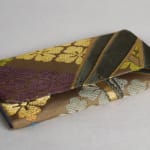







artisan's name unknown
Small Case with Light Blue Lining, Taisho Era (1912-1926)
Woven Silk
3" x 5"
Sold
Further images
-
(View a larger image of thumbnail 1
)

-
(View a larger image of thumbnail 2
)

-
(View a larger image of thumbnail 3
)

-
(View a larger image of thumbnail 4
)

-
(View a larger image of thumbnail 5
)

-
(View a larger image of thumbnail 6
)

-
(View a larger image of thumbnail 7
)

-
(View a larger image of thumbnail 8
)

In the Edo Period (1603-1868), a new industry appeared that produced and dealt with Fukuromono, which means purse, pouch, or bag in Japanese. In this industry fukuromono-shi (craftspeople) and fukuromono-ya...
In the Edo Period (1603-1868), a new industry appeared that produced and dealt with Fukuromono, which means purse, pouch, or bag in Japanese. In this industry fukuromono-shi (craftspeople) and fukuromono-ya (dealers) worked in tandem to create impeccable custom designed works.
At its beginnings, fukuromono were tobacco pouches made for men, which had come into fashion. In the Meiji period (1868-1912), they slowly spread to women and the variety of fukuromono blossomed to a wide range of accessories such as purses, clutches, and all sorts of cases.
Producing these bespoke works required highly skilled craftspeople from different disciplines - metalwork, lacquer, embroidery, and netsuke sculpture, to name a few – and quickly developed into a very specialized industry.
This case is a fine example of a work that resulted from these collaborative efforts. The two fasteners of the case are sculpted in ivory; the larger fastener is detailed with a carving on it. Both are attached with exquisite metalwork and latch onto a woven string of a rich brown color, contrasting against the shimmering fabric.
After over a century of time, the excellent condition of the work are evidence for the skills of the artists that created it and its previous owners loving care. The case waits patiently, perhaps curiously, to see how the contemporary eye will react its beauty and use it in the modern day.
At its beginnings, fukuromono were tobacco pouches made for men, which had come into fashion. In the Meiji period (1868-1912), they slowly spread to women and the variety of fukuromono blossomed to a wide range of accessories such as purses, clutches, and all sorts of cases.
Producing these bespoke works required highly skilled craftspeople from different disciplines - metalwork, lacquer, embroidery, and netsuke sculpture, to name a few – and quickly developed into a very specialized industry.
This case is a fine example of a work that resulted from these collaborative efforts. The two fasteners of the case are sculpted in ivory; the larger fastener is detailed with a carving on it. Both are attached with exquisite metalwork and latch onto a woven string of a rich brown color, contrasting against the shimmering fabric.
After over a century of time, the excellent condition of the work are evidence for the skills of the artists that created it and its previous owners loving care. The case waits patiently, perhaps curiously, to see how the contemporary eye will react its beauty and use it in the modern day.
Signup for our Newsletter
You will receive two emails a month from us. One introduces artworks and design works from Kyoto's hidden sources and the other is stories from Misako, sharing insights into Japanese culture.
* denotes required fields
为了回应您的查询,我们将根据我们的隐私政策处理您提供的个人数据。